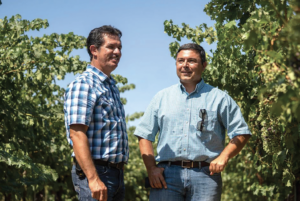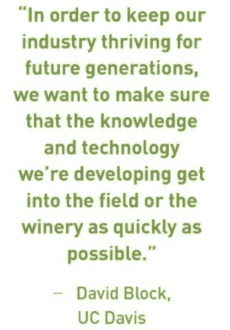UC Davis, California wine grape grower experimenting with new methods

Under the hot summer sun of the San Joaquin Valley, just south of Merced, Miguel Guerrero of The Wine Group is trying a new high-wire act. In collaboration with University of California-Davis Cooperative Extension, Roduner Ranch vineyard manager Guerrero is experimenting with Cabernet Sauvignon vines and other varieties elevated by a single wire at 66 inches — plantings that are 2-3 feet higher than the traditional wine grape canopy.
The high-wire method causes grapes to grow downward and reduces the need for manual labor, allowing vineyard management practices such as pruning, leaf removal, berry thinning and other processes to be performed mechanically at just the right time for a fraction of the cost.
“The beauty of the high-wire system is that the fruit zone is really defined — a solid wall of grape clusters — and the pruning machine can just zip right alongside the vines,” said Kaan Kurtural, a UC Davis Cooperative Extension viticulture specialist. “We can carry more crop, and with mechanical leaf removal, we get that sun-dappled exposure that feeds the fruit. Less leaf cover means the vines require less water and the grape quality is much better.”
Surprising the skeptics
Kurtural has established a small demonstration vineyard planted on high wires at Oakville Station in Napa that is completely mechanized. In the tradition-steeped wine industry, some worry that mechanizing labor practices in vineyards will lower the quality of the wine. One industry partner, The Wine Group headquartered in Livermore, has participated with UC Cooperative Extension on field trials showing that mechanical practices can actually enhance quality.
The Wine Group is an industry giant that farms the 3,000-acre Roduner Ranch and many other properties in the San Joaquin Valley and along the Central Coast. The company owns a variety of brands that include Concannon Vineyard, Cupcake Vineyards and Almaden Vineyards.
While Napa and Sonoma valleys are better known for wine production, vineyards in the San Joaquin Valley produce 70 percent of the volume of the wine grape crush in the United States. Grapes from District 13 (the area surrounding Fresno 100 miles out) typically sell for about $300 per ton, while Napa Valley grapes average more than $5,000 per ton. With a thinner profit margin, San Joaquin Valley vintners have a greater incentive to try out mechanized vineyard practices.
“Before, growing grapes in the San Joaquin Valley was all about production and big yields,” said Guerrero, gesturing toward row after row of vines from the cab of his pickup truck. “But we started attending UC Davis Cooperative Extension meetings, and we started learning a little more about what to do to improve ripening and bring out the best in the grapes. With our new canopy management practices, our winemakers are noticing a difference in the quality of our reds.”
 Keeping wine in California
Keeping wine in California
Today, the $35 billion California wine industry accounts for 90 percent of the nation’s wine production and is the fourth-largest wine producer in the world. Back in the 1930s, however, viticulture in California was in shambles after more than a decade of Prohibition. University of California scientists provided research-based knowledge that helped rebuild the industry, which still includes many small, family-owned businesses that have passed along through generations.
At UC Davis, Kurtural and other researchers continue to collaborate with winegrowers and winemakers on labor and other critical issues.
“In order to keep our industry thriving for future generations, we want to make sure that the knowledge and technology we’re developing get into the field or the winery as quickly as possible,” said Professor David Block, chair of the UC Davis Department of Viticulture and Enology. “I think the best solutions to industry challenges — labor, water, soil, yields, quality — are going to come from collaborations between farmers, the university and tech companies.”
The V&E department’s ongoing partnerships with J. Lohr Vineyards and Wines, the Robert Mondavi Winery, E.& J. Gallo Winery, Tule Technologies, Cypress Semiconductor and many others have advanced wine science both in the vineyard and in the winery.
Out among the vast vineyards of the San Joaquin Valley, UC Davis Cooperative Extension farm advisor George Zhuang, viticulture specialist Kurtural, as well as researchers from Fresno State University, continue studies to get the very best from hot-weather wine grapes.
“Our partnership originally started with one trial project on our 2,500-acre ranch in Fresno,” said Nick Davis, a vineyard operations manager for The Wine Group. “Now we have four. I think that shows how well The Wine Group and Cooperative Extension work together.”
— By Robin Derieux, UC Davis







